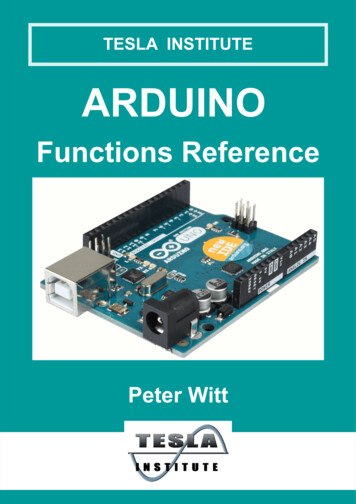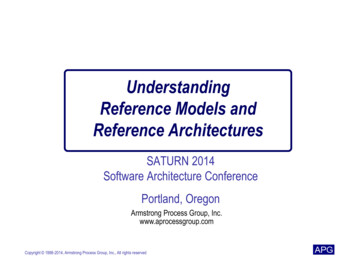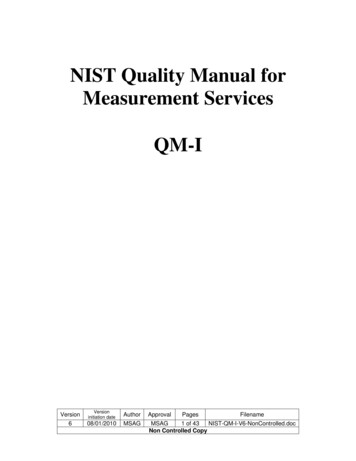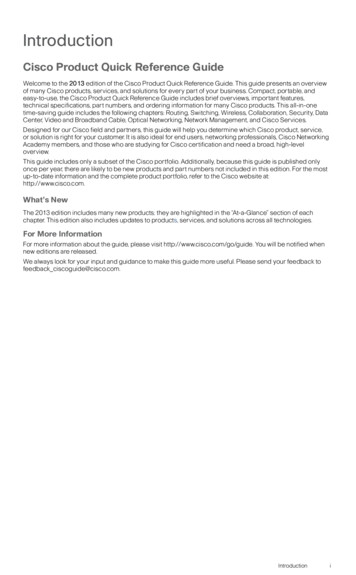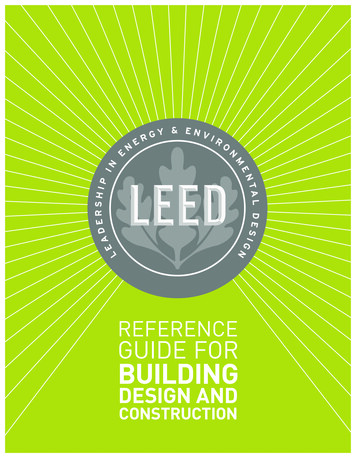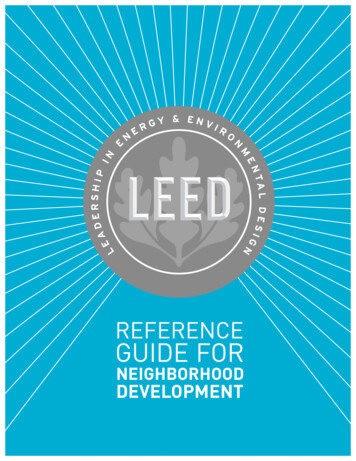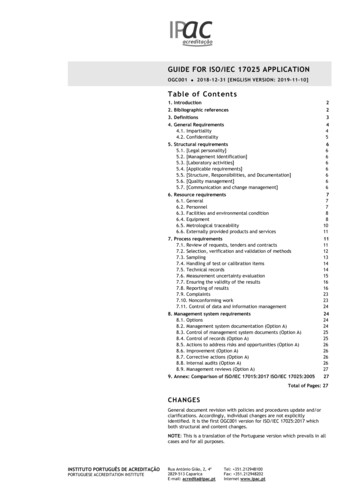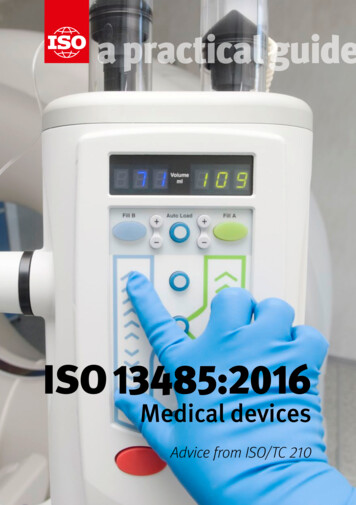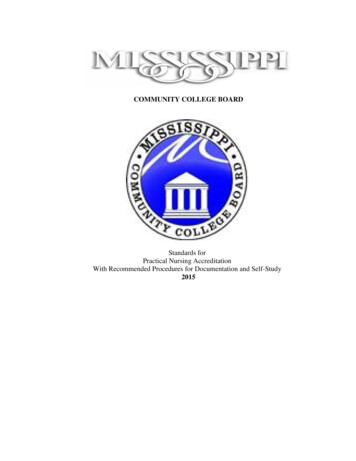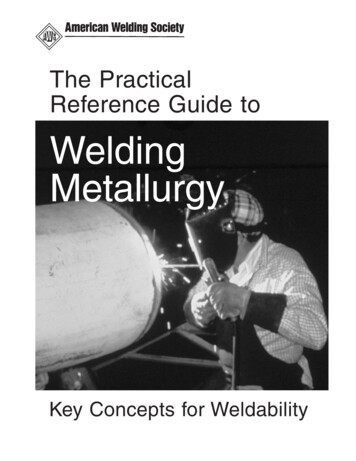
Transcription
The PracticalReference Guide toWeldingMetallurgyKey Concepts for Weldability
THE PRACTICALREFERENCE GUIDEtoWELDING METALLURGY—Key Concepts for WeldabilityCompiled/edited/written byTed V. WeberWeber & AssociatesThis publication is designed to provide information in regard to the subject matter covered. It is made availablewith the understanding that the publisher is not engaged in the rendering of professional advice. Reliance uponthe information contained in this document should not be undertaken without an independent verification ofits application for a particular use. The publisher is not responsible for loss or damage resulting from use of thispublication. This document is not a consensus standard. Users should refer to the applicable standards for theirparticular application.550 N.W. LeJeune Road, Miami, Florida 33126
AUTHOR’S NOTESFor many, the metallurgical aspects of welding are not well understood and many of the books and technicalarticles dealing with the subject are sometimes difficult to master because the lay person does not have thetechnical background necessary to digest them. Generally, what welding personnel need is a basic understanding of the metallurgy of welding that is sufficient to aid in solving many of the day-to-day problems offabrication or repair welding.To that end, I have approached the subject less stringently than most, and have offered some basics that willaid the non-metallurgist in understanding why problems occur, and how to avoid them. While it is necessaryto touch on the science in several areas, I have endeavored to limit it to the minimum needed for a practicalunderstanding. I cover the effects of the various elements that make up our alloys, specifically from the weldability standpoint. The effects of cooling rates and the resulting structures are also covered from the mass effect and hardenability standpoints—a perspective I feel will be very helpful in understanding and solvingmany of the common welding problems.I hope this Guide will be helpful to all, especially those non-metallurgists who have a need to avoid weldingproblems so often caused by overlooking the metallurgical considerations.Ted V. WeberHendersonville, TennesseePhotocopy RightsAuthorization to photocopy items for internal, personal, or educational classroom use only, or the internal,personal, or educational classroom use only of specific clients, is granted by the American Welding Society(AWS) provided that the appropriate fee is paid to the Copyright Clearance Center, 222 Rosewood Drive,Danvers, MA 01923, Tel: 978-750-8400; online: http://www.copyright.com 1999 by the American Welding Society. All rights reserved.Printed in the United States of America.ii
TABLE OF CONTENTSPage No.Introduction.1Definitions .1Metal Structures .3Metal Forms.5Diffusion .8Solid Solubility .10Shielding and Purging .13Residual Stress .13Phase Transformation .15Hardness and Hardenability.15Effects of Elements.20Grain Size.20Stainless Steels.21Sensitization of Austenitic Stainless Steels .23Aluminum and its Alloys .24Copper and its Alloys .25Nickel and its Alloys .25Refractory Alloys .25Repair Welding .26Summary.27Selected References.27Glossary .28iii
Welding Metallurgy—Key Concepts for WeldabilityIntroductionDefinitionsKnowledge of welding metallurgy can be beneficialto almost every aspect of fabrication, inspection,and failure analysis. Too often, problems occur repeatedly because the metallurgical aspects are notsufficiently understood (note Figure 1), and as theold saying goes, “When you continue the exact samepractices, why should you expect different results?”A discussion of metals requires the first step to be areview of several basic definitions. Many definitions used in this guide are from Webster’s. A metalis defined as “Any of a class of chemical elements generally characterized by ductility, malleability, luster, andconductivity of heat and electricity.” Examples of metals include gold, iron, aluminum, and silver. Metalscan be found in their natural elemental state, suchas the case with gold and silver, or combined withother elements such as oxides, sulfides, sulfates, etc.These combined forms of metals are referred to as“ores,” and the elemental metal must be first extracted, or separated from, the other constituentsbefore combining them in desired alloy forms.While the subject of metallurgy, and its subsetwelding metallurgy, encompasses a very large technical base, there are several basic issues that can bestudied and implemented to aid in avoiding problems associated with fabrication and repair welding. These basic issues will be discussed in simpleterms and hopefully with an approach that will enable a non-metallurgist to grasp and apply them inorder to avoid common welding problems.Since carbon and low-alloy steels are used predominantly in many industries, these alloys form thebasis for much of this metallurgical review. An understanding of the steel basics can then lead toother alloy groups including austenitic stainlesssteels, copper and aluminum alloys, and the highalloys that include the nickel alloy groups. Thesefamilies of alloys will also be discussed, but to amuch lesser degree.An alloy is defined as “A metal that is a mixture oftwo or more metals, or of a metal and something else.”The phrase “something else” in the definition canrefer to the combinations of metals with ceramics,called “cermets,” or various other combinations.Some metal alloys occur naturally while others arecombined in furnaces by intent to develop particular mechanical or physical properties. Examples ofvery common alloys include carbon steel, a mixtureof primarily iron and carbon, and the austeniticstainless steels that are primarily mixtures of iron,chromium, and nickel. The man-made alloys alsocontain many other elements that may affect theirproperties; these will be discussed later.Figure 1. Liberty ship failures from the World War II era: massive hull fractures due to a combinationof poor-quality steel, less-than-adequate welding procedures, and low temperatures in the North Sea.AWS Practical Reference Guide 1
Welding Metallurgy—Key Concepts for Weldability Introduction Knowledge of welding metallurgy can be beneficial to almost every aspect of fabrication, inspection, and failure analysis. Too often, problems occur re-peatedly because the metallurgical aspects ar



